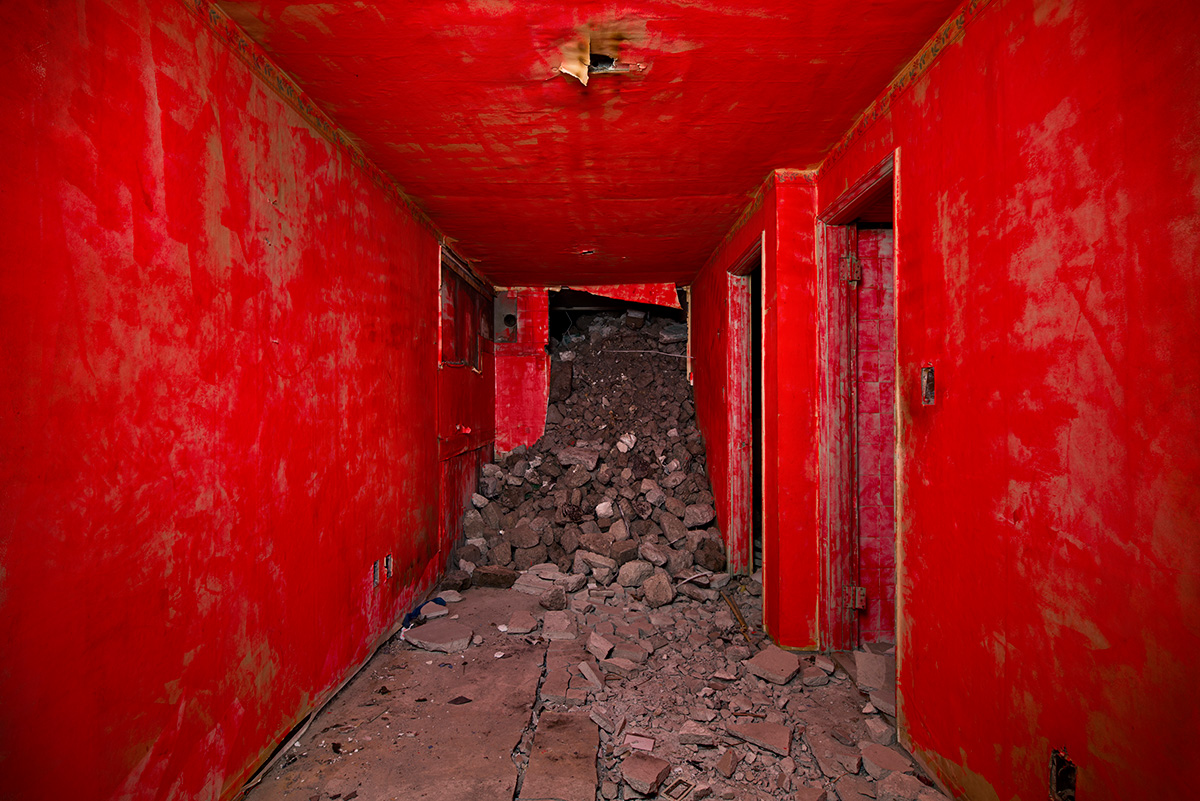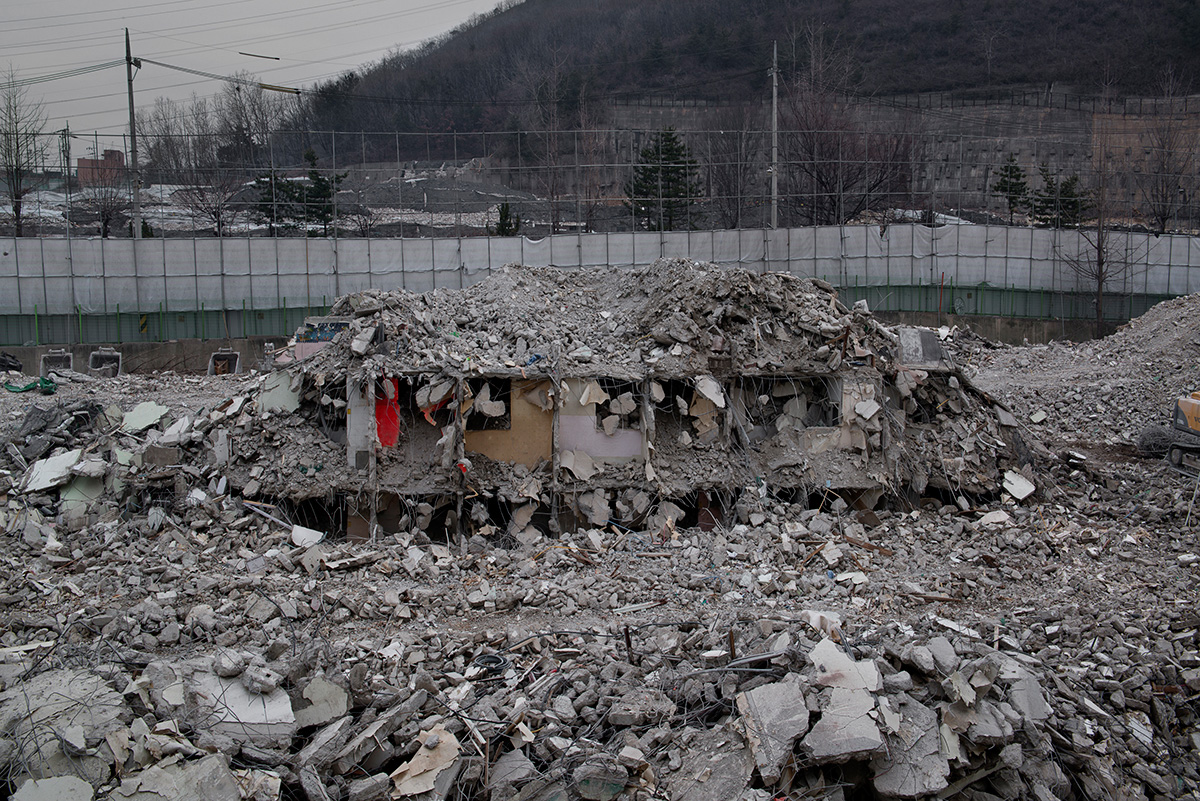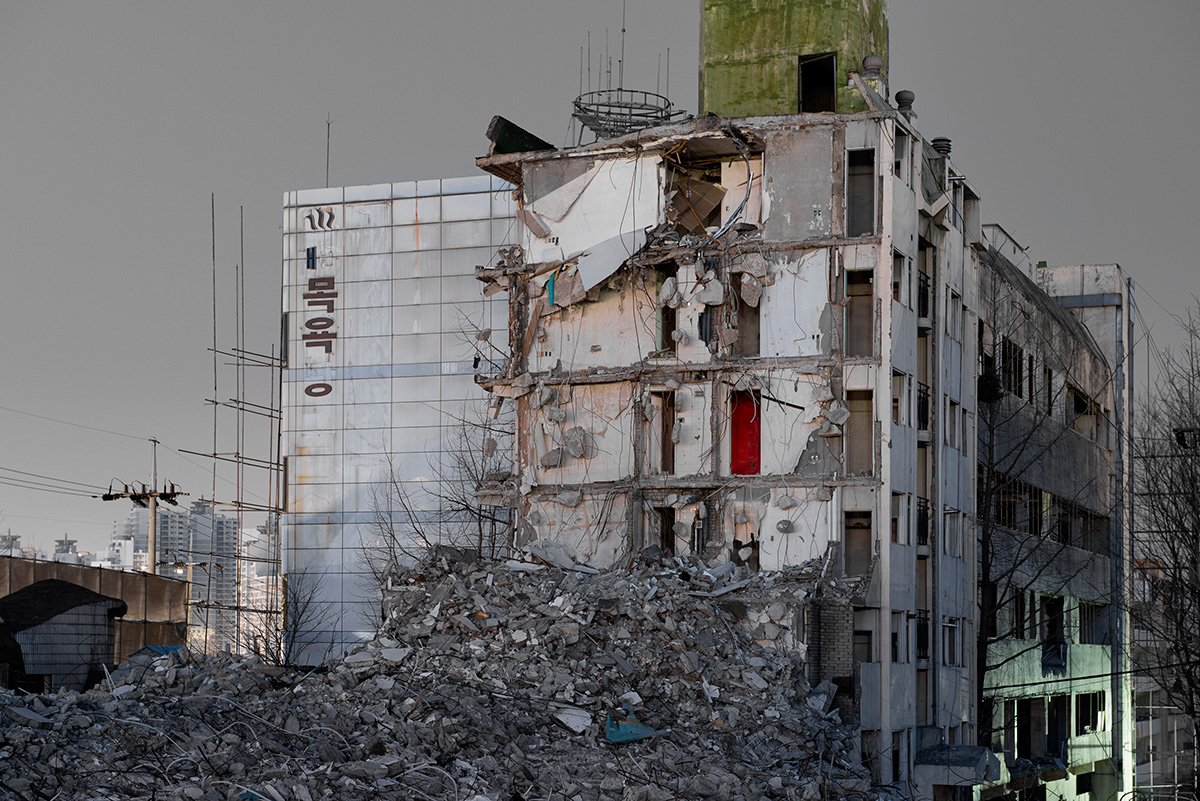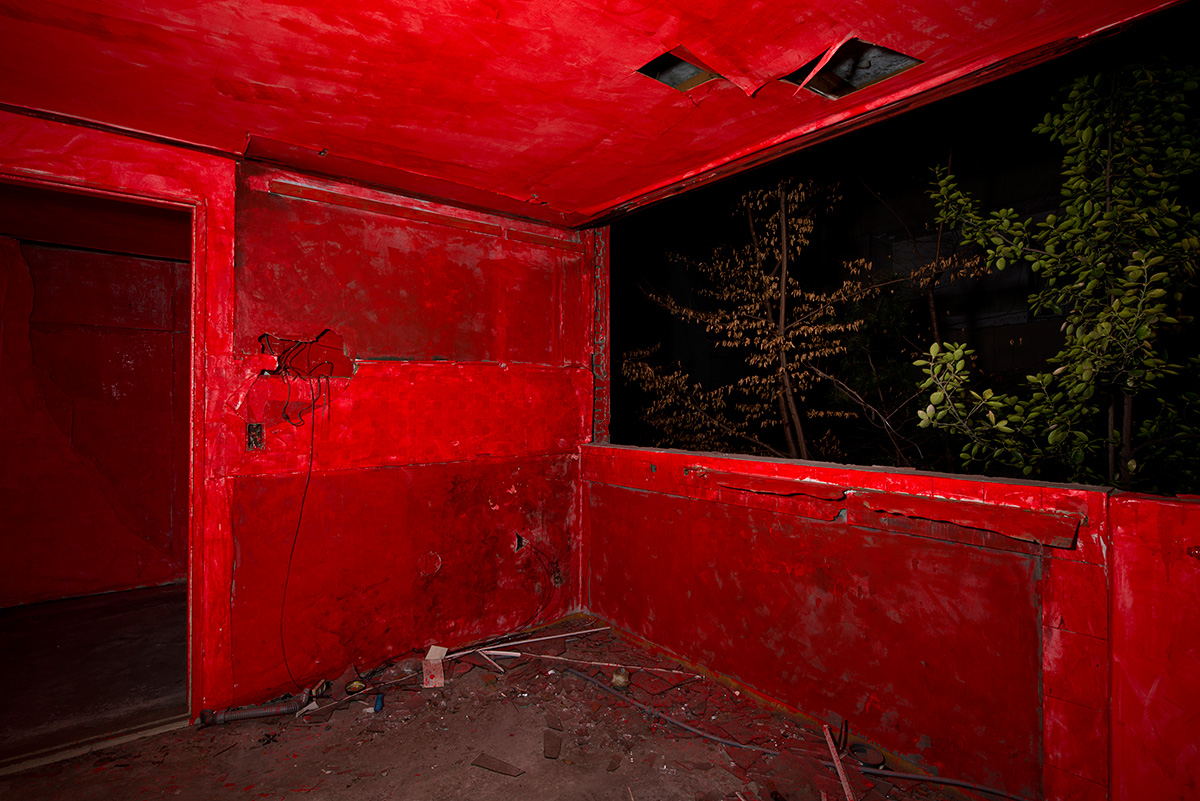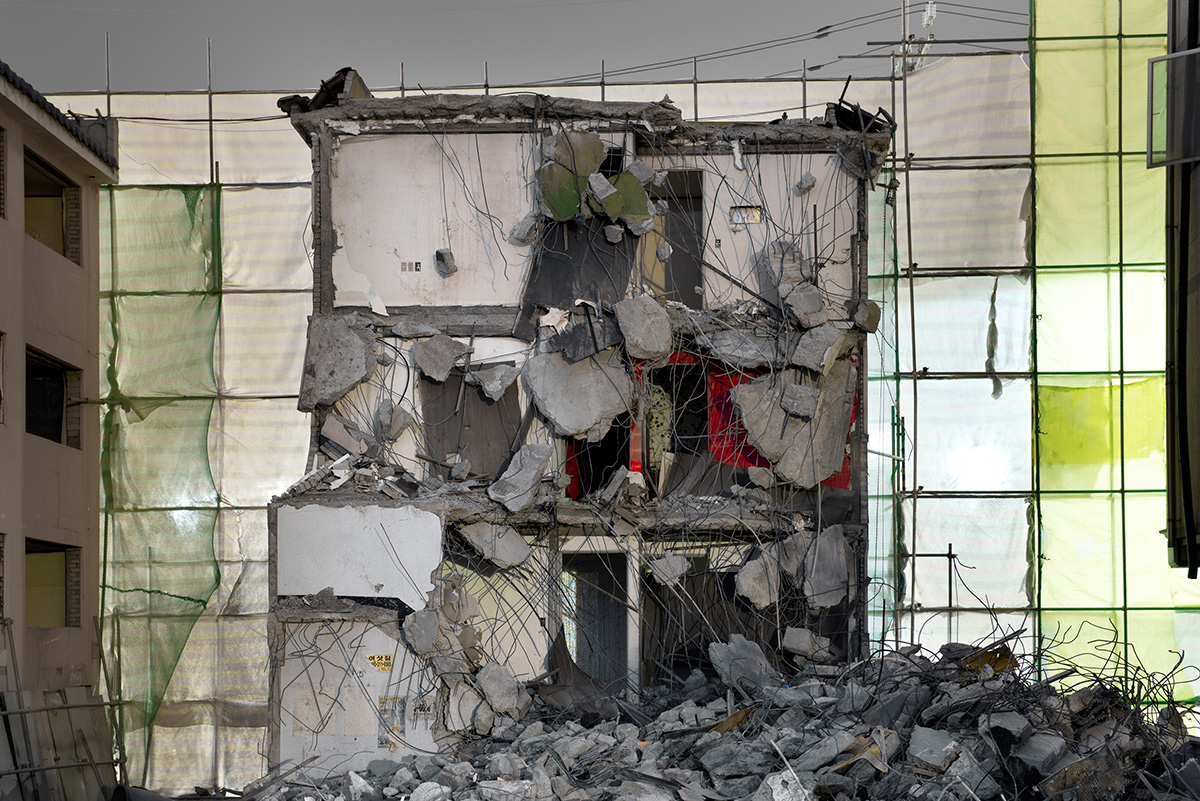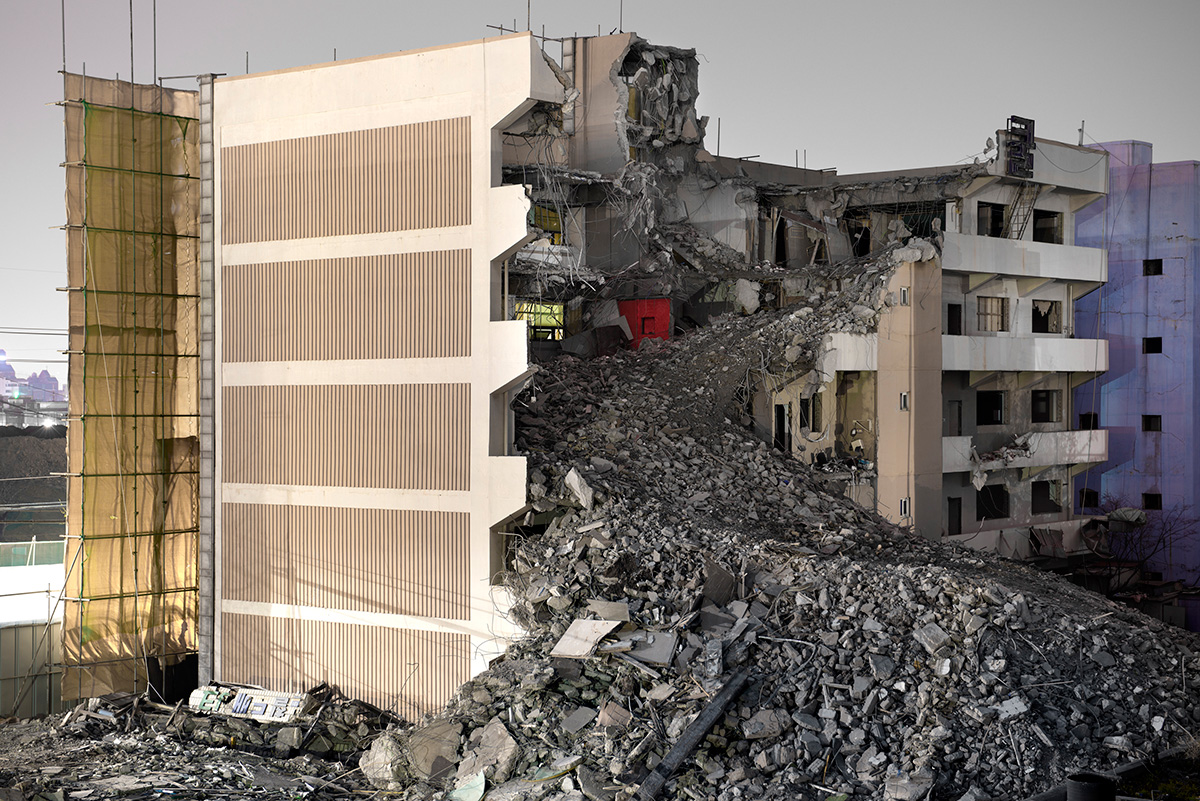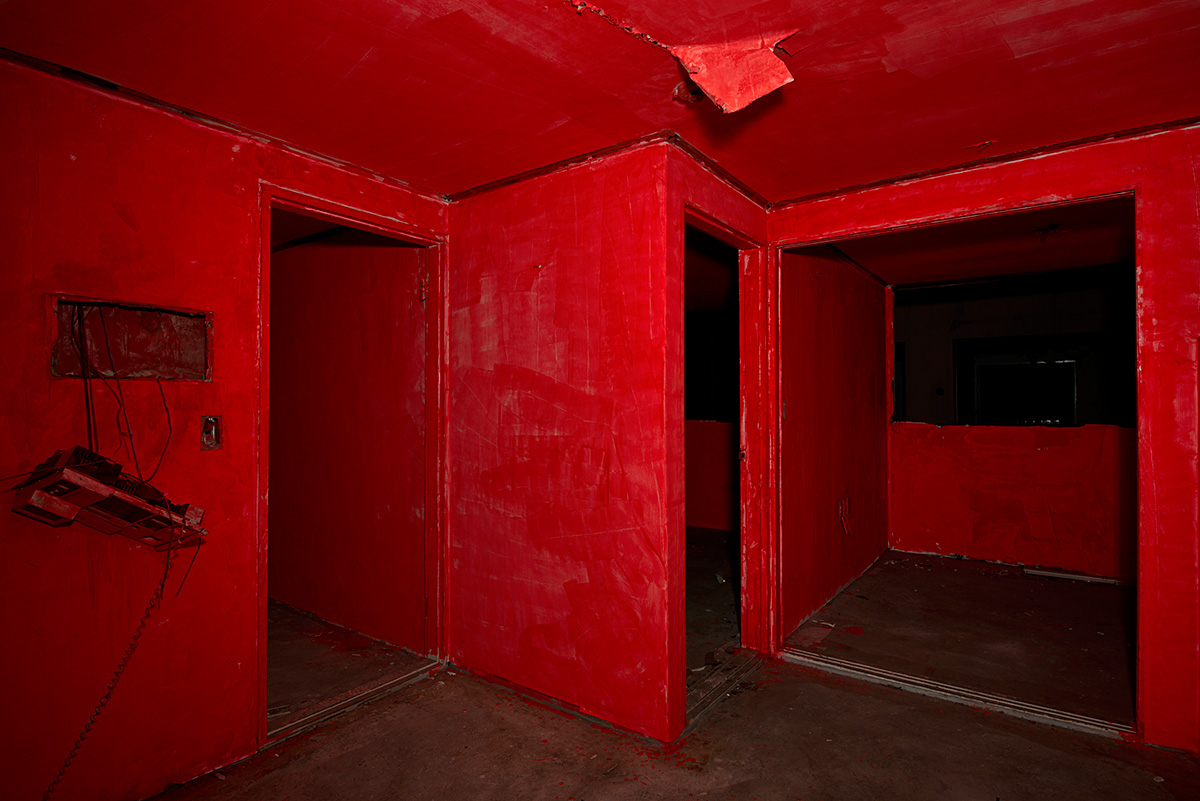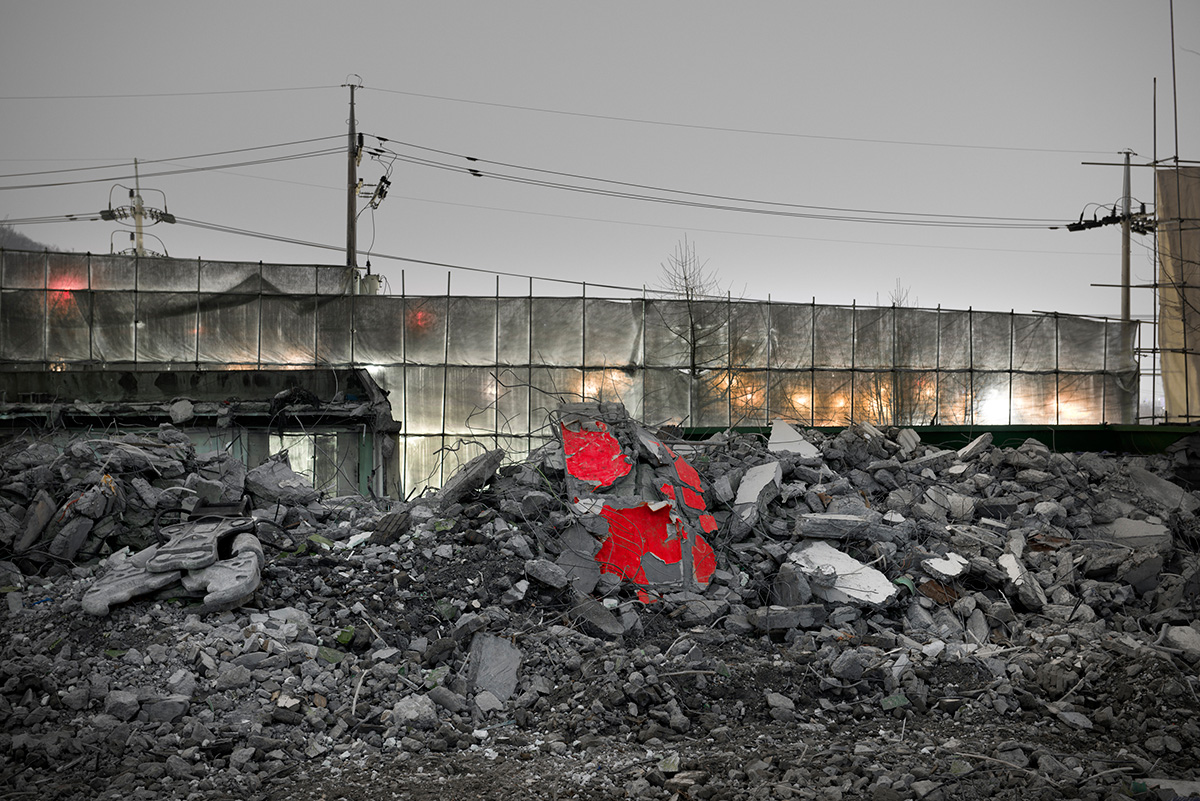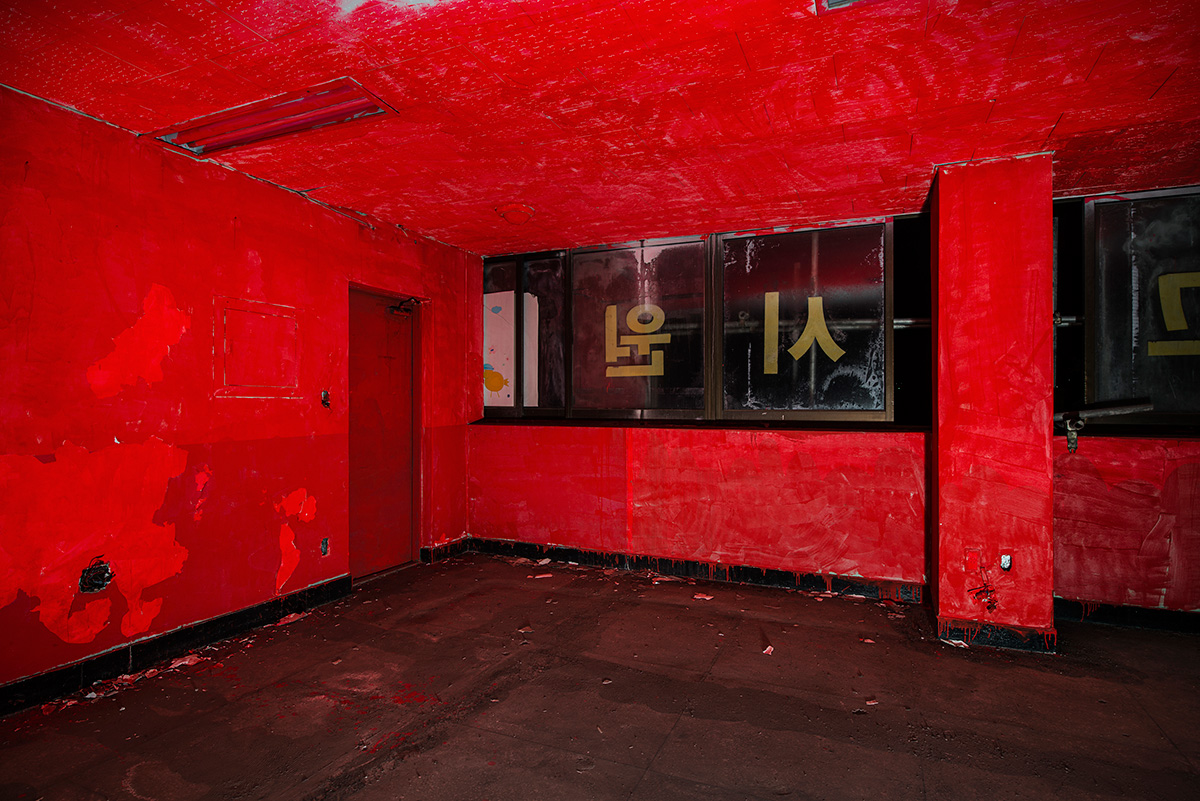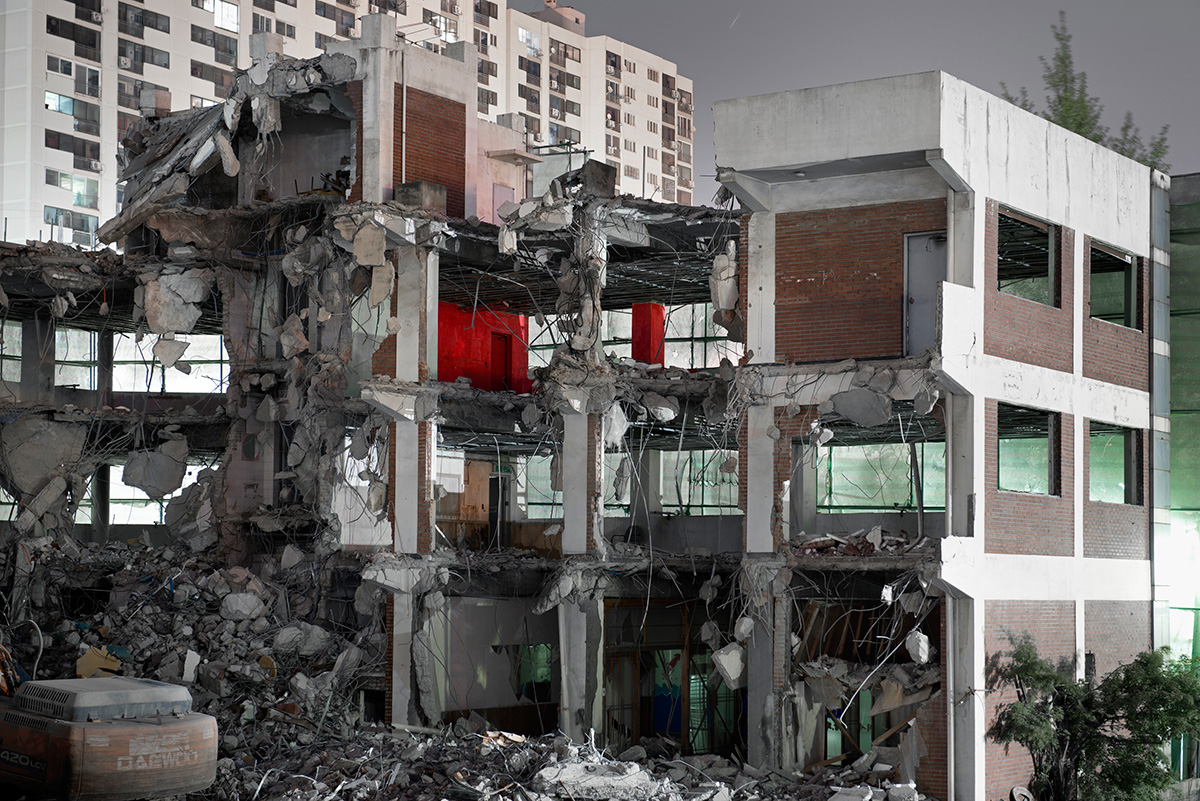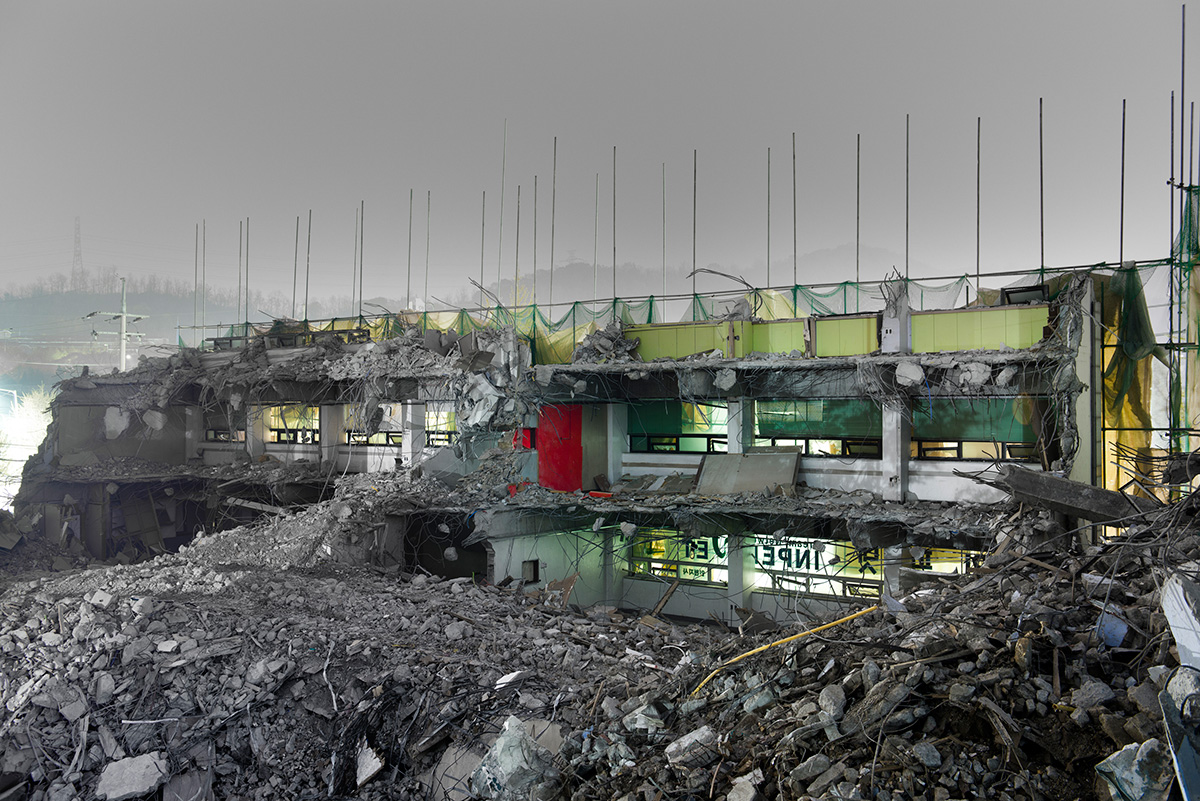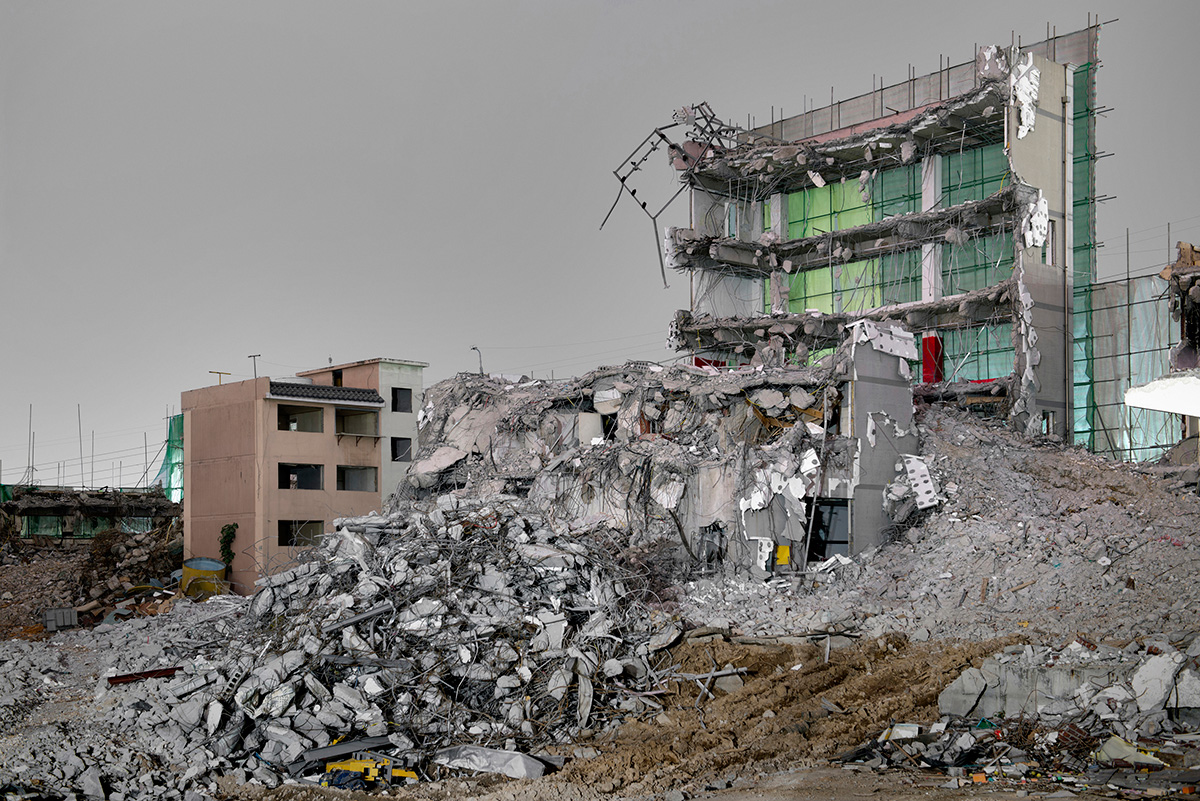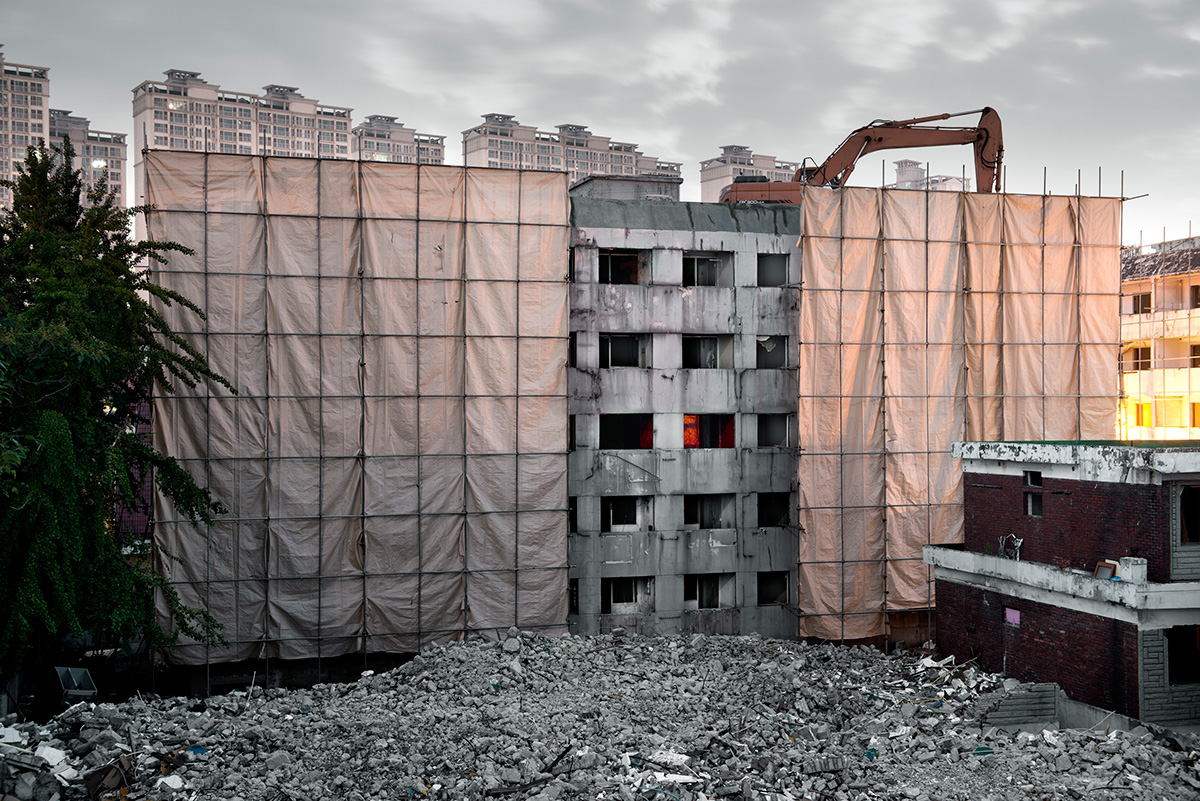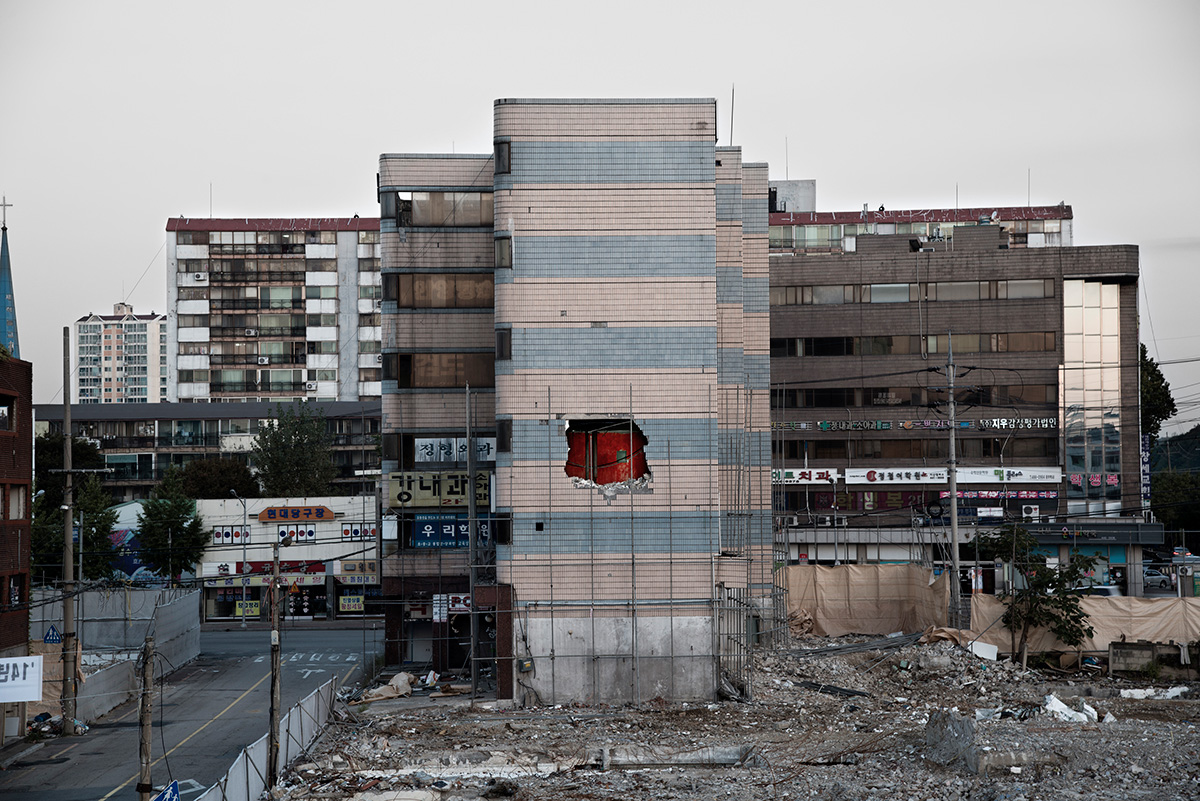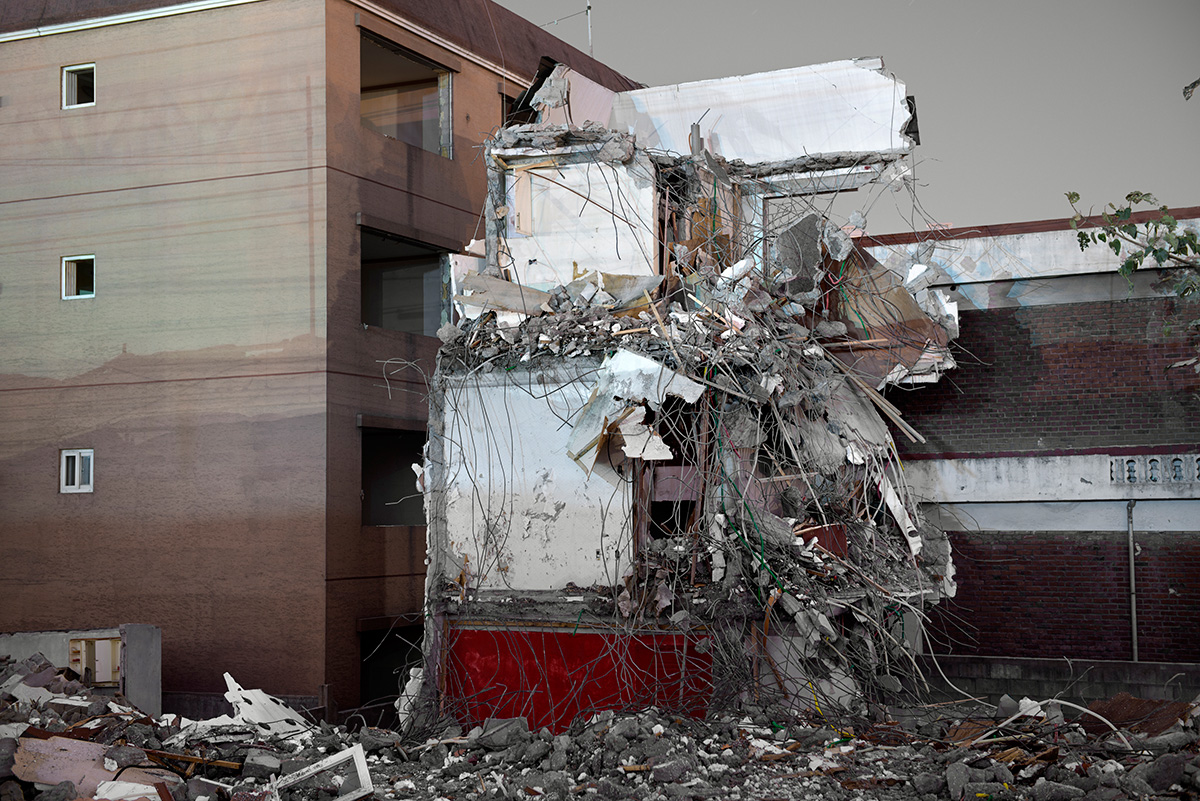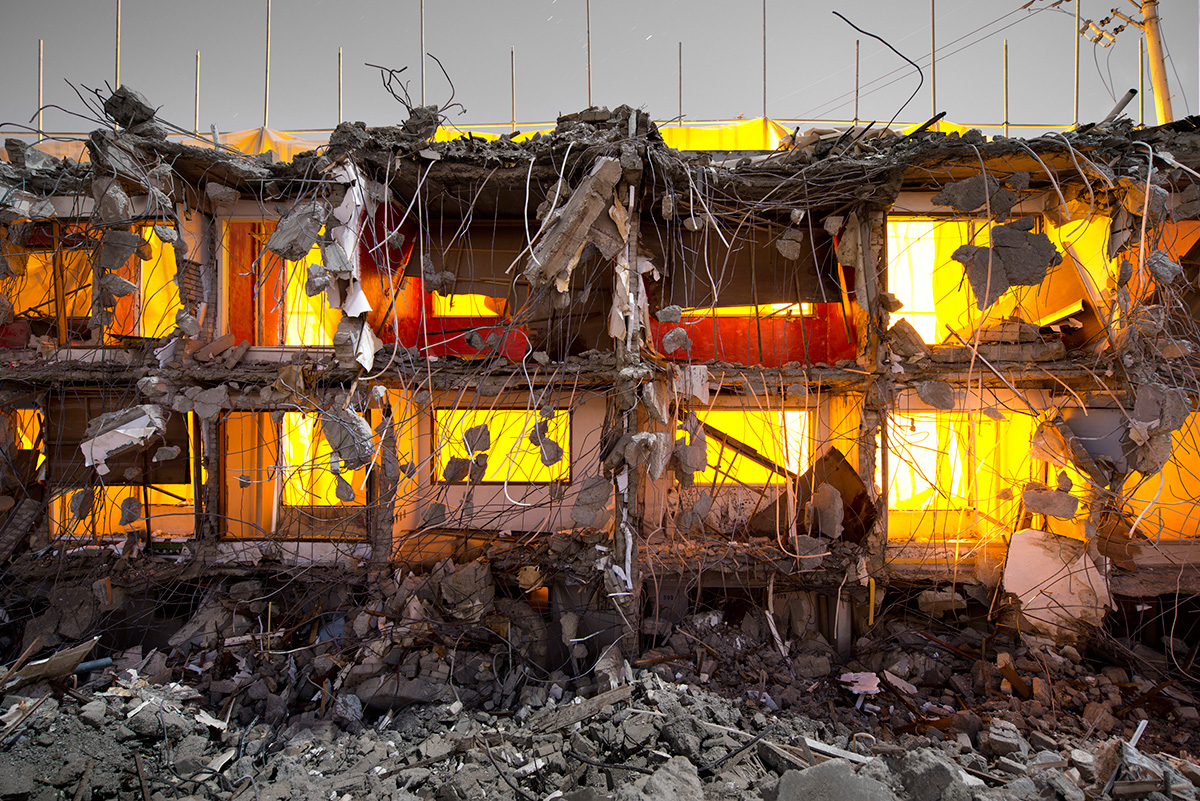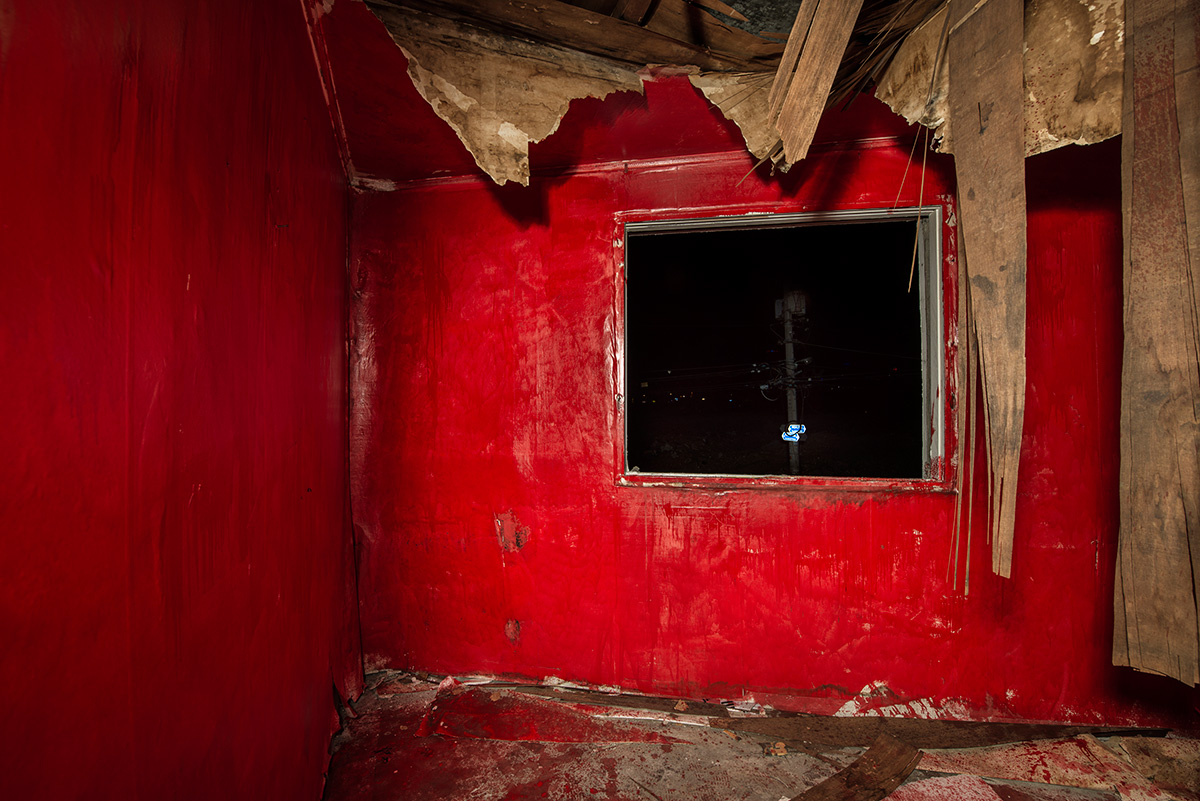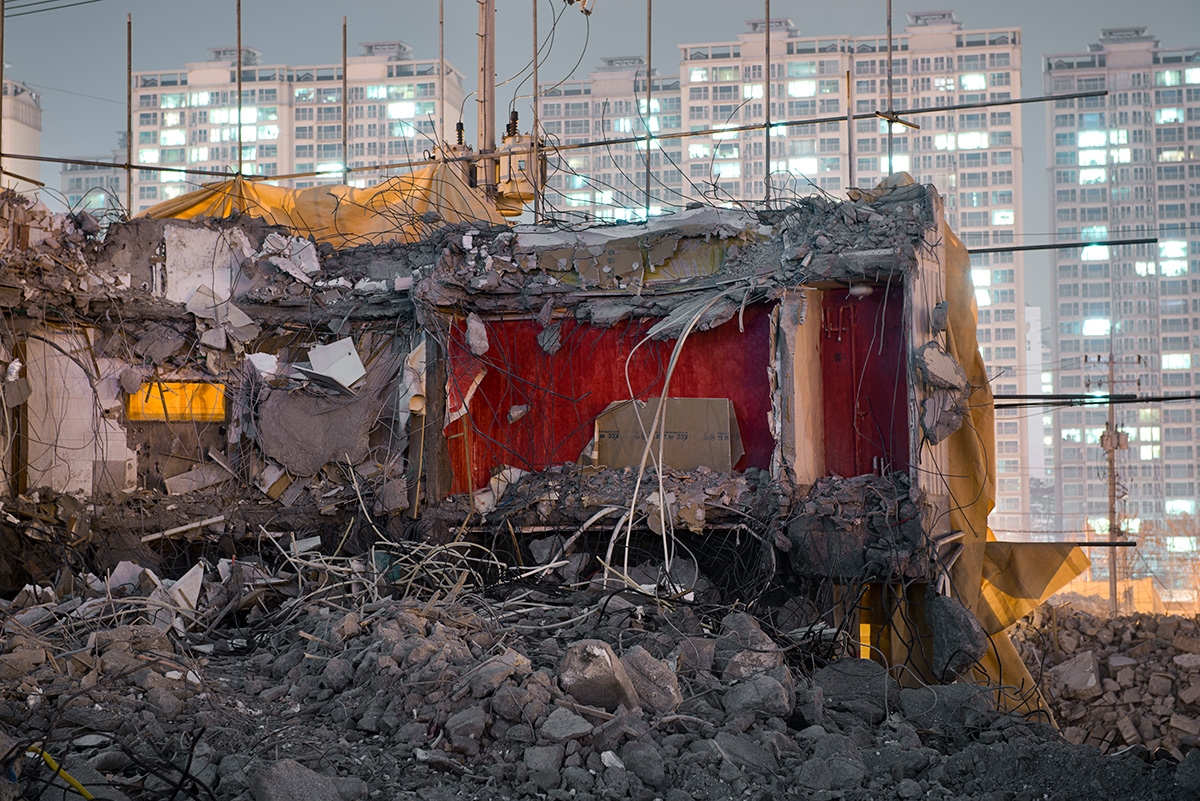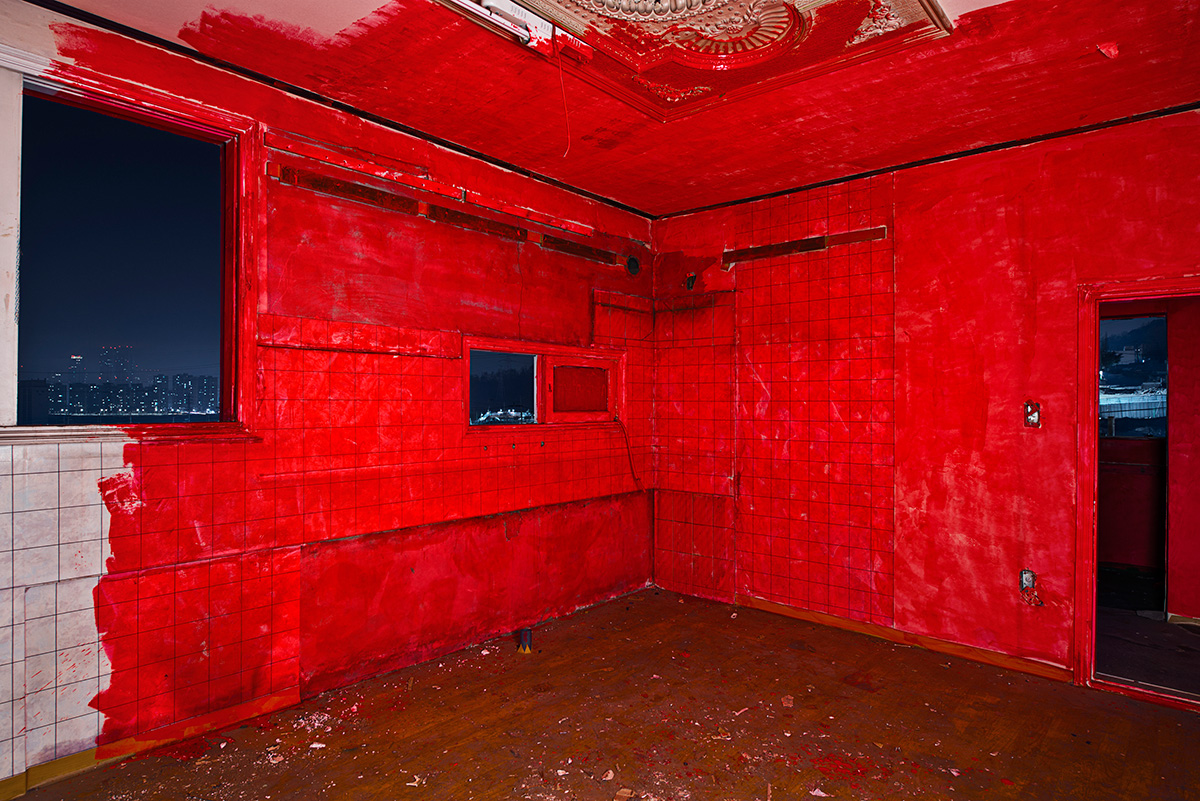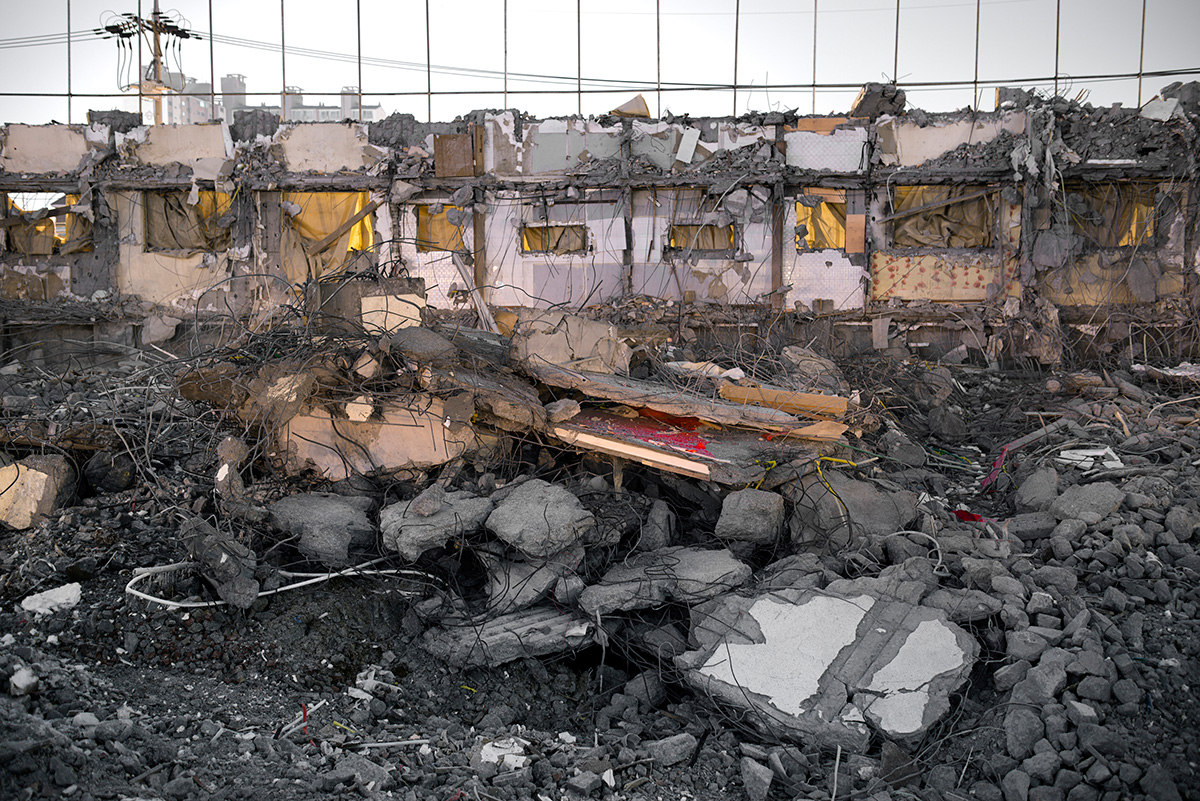2014.10.05 18:37
Jihyun Jung 정지현 <Demolition Site>
조회 수 641 추천 수 0 댓글 0
Demolition Site
I sneaked into a building that was scheduled to be torn down, and painted the inner walls red before I photographed them. After the demolition I went in again, looking for traces of that red paint. By documenting the red walls that were broken down into smaller and smaller pieces as the building was de¬stroyed, I chased after the fate of this red room that would, in the end, disappear into the void as an anonymous piece of concrete. The red room was a private space that dissolved when faced with a system of redevelopment. I reveal what kind of space the city we are living in is, and how the city as a place of community is vanishing. It is how I raise questions about the rash thoughtlessness of urbanization. Finding the red room where traces of an individual’s life still reside from within the spectacle of demolition is a work to recover and recognize the city as a place for living. The photographs were taken at the demolition sites of Lu 1 City in Gajeong-dong, Incheon, and Deokcheon maeul, Anyang. Neither site exists today.철거현장(Demolition Site) 철거 예정인 건물에 잠입하여 내부를 빨간색으로 칠한 뒤 촬영하고, 실제 철거가 이루어진 다음에 다시 들어가 빨간 페인트의 흔적을 찾았다. 건물이 철거되면서 점점 작은 덩어리로 쪼개지는 빨간 흔적들을 기록하며 결국 한 점의 콘크리트가 되어 사라지는 빨간 방의 운명을 추적했다. 개인의 공간인 빨간 방은 재개발이라는 체제 앞에서 무기력하게 사라진다. 나는 이러한 과정을 통해 지금 우리가 사는 도시가 어떤 공간인지, 공동체 공간으로서의 도시가 어떻게 사라져 가는지 보여 줌으로써 맹목적으로 달려가는 도시화에 문제를 제기한다. 스펙터클한 철거 현장에서 개인 삶의 흔적이 존재하는 빨간 방을 찾는 과정은 도시를 삶의 공간으로 회복하고 재인식하는 작업이다. 지금은 완전히 사라진 인천 가정동 루원시티와 안양 덕천마을 철거 현장에서 작업했다.
Demolition Site – Diary of Work
2013-09-01Until now, I’ve been always pressed for time by coming in and out demolition sites with following thoughts.
‘What if the red room, for which I sent several nights, suddenly disappears or may be buried with no traces?’
‘What if the demolition is done earlier than planned and I may not reach the end of work?’
‘What if someone notices me and kicks me out?’
In the end, all the concerns were actualized last month of my work.
Redevelopment zone has been abandoned over 5 years. All demolition projects were completed earlier than expected with new government’s plan for 2013 and preparation for Incheon Asian Games in 2014. To be specific, the demolition site was perceived as a place to be ameliorated for welcoming foreign visitors.
Due to the earlier demolition, all the red rooms, which were scattered over the site, suddenly disappeared or were buried.
2013-06-06
During the daytime, I had been searched out red room’s concrete fragments for several hours.
On tracing the fragments with lots of disappointments, I automatically got to calculate cost for expensive paint as well as my time for the work. Also, my colleagues came to my mind with their smiles although the work was not easy. All the thoughts gave me a hard time.
With sunrise, I came back to my studio without any fragments of red rooms.
I could not fall asleep even though I brought down the curtain.
I had been tossed and turned for awhile. I got to turn on my computer. Then, habitually, I surfed various news websites and searched names of demolition site which has been the only way I got information on demolition zones.
There was a news attracted my attention.
The article said that illegal enforcement for demolition generated asbestos which is categorized into the first level (group1) carcinogens.
The photo in the article showed me a familiar place where I was doing my painting work for several days last month. At the moment I froze for a while and was staring at the computer screen. Yes, it was a huge shock to me.
From the first time I decide to enter demolition site, I made up my mind that I may take some risks. I bought the most expensive dust mask, security shoes, protective suit, and helmet just in case. Yet, I could image such an invisible danger or risk at all. The asbestos is very risky thing which come to my mind via illegal demolition work and is impossible to be prevented by the dust mask.
The work for which I made all my efforts ends up harming my devoted colleagues and me as well.
I was in panic. I seated myself during all the afternoon and evening. I could not sleep.
I kept asking myself why I have to do this work. The question should have been asked before starting the work. The challenge, which I always face whenever I am working on urban related work, is that I come to be placed in the middle of urban issues and problems.
Knowing unknown facts of the city, I naturally got to have my own perspective toward the city which made me hard to keep certain distance between me and my object of work. For a joke, my colleague artists and I had conversation as follow. “In Korea, if someone works on urban issues without becoming social activist, the person might be unscrupulous.”
I am not that brave to become a social activist. Thus, I repeatedly go to the social activist side and intentionally come back to my place meaning art side during the whole process of my work.
In city, all of us are always exposed to a certain place which threats our healthy lives. Sometimes, I encounter young students who attend school located in right beside of my site. They stared at red-paint-covered guy with bizarre look. The only thing I can tell them is to make a detour or take other way in order to avoid danger. Once I am very brave I might say was follow. “There exists asbestos which is categorized into the first level (group1) carcinogens right beside of your school. If you keep attend this school about 6 years, you may get a cancer after long incubation period.”
2013-09-01 again
I expected that I may be able to keep work until early 2014. However my work was forced to stop in August 2013 due to demolition plan moved up earlier. I stayed up several weeks for searching other demolition sites. After long journey with trial and error, I found a site in Anyang.
As always, the first place I visit before starting my work is an old real estate agency. The agency very well knows about the area.
This area may be demolished in about several months for huge apartment complex. If so, finding cheap and good place for studio may not be easy. Thus, I was in hurry to search and contract a place for my studio. Then, I rushed to move my studio to Anyang from Incheon.
While I kept thinking, I could not get a clear answer to convince myself for going on my work with taking risks. Instead, I raised another question. If I am not the one taking risks for the work, who will take the risks and enter this place?” I could not find an answer for this question too.
Probably, I may be able to start the work because I could not get answers for those questions.
I thought that my work might trace my town and soul of memory. I wanted to end up my memories which had been supported my work on city.
On the way to the site which I picked in the afternoon, about 2 am, the car was very silent.
Although I might need permission for photographing for a moment, I concluded that official permission requires much time and may hinder my work because I only have few days before demolition.
Okay, let’s go ahead.
Like other sites, conflict in this place already generated the 3 fatalities over last couple of weeks. Of course, security was tightened up. For larger compensation, residents took a firm stand with knife against group of service gangsters. Even though facing those kinds of real situations are inevitable for me in order to keep developing my night work, it was very scary to me.
In fact, security of demolition site is not that tight. Over last year, I came to recognize the workers’ route which enabled my painting in the middle of night. During the painting work, I had to lower my light in order to avoid get caught by security guard. Thus, I cannot know whether I am doing well. To tell the truth, I am not able to think about anything at all.
In demolition sites, there are feral cats. Hungry feral cats follow sounds and gather toward it. If someone approached the site during the night, she or he must be the elder or the middle aged women. They came to feed the cats. Hence the cats cried out and wander around whenever they hear any sound. When the cats cry, the sound is very similar to baby’s crying. This kind of sound from destroyed buildings is much scarier than staying a night in ruined house with fabled ghosts.
After spending whole night for the painting in hurry and tension, I came back with red-covered sweating body and face as well as arsenic acid dust, asbestos dust, and disgusting smell of paint. After thirty minutes of shower, I encountered sunrise.
I felt worm-wriggling in my bed while I was lying. The feeling might be due to dry air in my studio or remained dust from the site. Hence, I could not sleep well and was often ill during this work period.
Anyway, after completion of paining work, I installed studio-use-big sized power pack flesh light and took photos of the red room. The light of flesh seemed much brighter and lasted far longer with 1200 watts light.
This moment is the easiest instant for being caught by security guard.
Yet, if there is sparkled red room in dark demolition site, none of violent service gangsters easily approaches.
However, at the last moment of work, concerned matters came to be realized.
Through the demolished buildings, red and blue lights and familiar sound came to me.
Definitely, police!!
5 am in the morning, there were four people in the red-coated room. One wore white protective suit and dust mask, two from police department, and the last one with tough-looking was in charge of securing the site.
I expected to be questioned such as “What are you doing here?” or “Who are you?”
But instead, they asked as follows. “What is your affiliation?”
I was very impressive by the question.
2014-01-15
The work in Anyang went smoothly before I got a call from security manager 2 days ago.
The manager was very enthusiastic about my work and even he took photos and sent me when my red room popped-up in the middle of demolition work. Also he was very generous to me. In addition, every condition was fine including the location of my studio. I could visit and check the site every day because my studio was located right beside of the site.
Thus, I could end up with planned amount of photos within planned time period. Also, in 2014, the site was replaced by model house of “s” company covered by banners as expected.
There was a small building under ongoing demolition. Lots of dead cats were witnessed at the basement of it due to the polluted water.
Around the time, I came to know better and more convenient way for getting information on demolition sites. That is to be a member of internet café or club for will-be-residents in new apartment. The member also seemed very happy with the completion of demolition work. The entire situation was much closed to happy-ending.
Due to secured relief? I made mistakes when I was about to complete my work.
First mistake was I was not punctual.
Usually I started working around 2 am but I initiated my work around 11pm on that day. I wanted to finish work earlier and comeback to regular life.
Unfortunately, the early visit led me to encounter the last resident. The person was very hostile to me. I thought that he might be threatened my look. Thus, I took off my white protective suit and mask. In addition I tried to say that I am not the person who harms him. In general, the last resident might be conceived as one of the poor person who has no place to go or live. Of course, there are some people are so.
Looking more in-depth, yet, most of the last residents want more compensation by making troubles and causing matters. Among them, there are some who commutes to the site from their other house in order to get more compensation. Thus, the best policy in site is to avoid having conversation on controversial topics or issues might cause conflicts. If I cause troubles, a person who permitted me to enter the site, may be in difficult situation as well as myself.
I made the second mistake here.
I got to have interested in a person who had been lived and lasted here as a one last person. Above all, I was very curious on the one. Moreover, I thought that the person might be linked with my next work. Thus I started to have conversation.
It was the problem that I had conversation with native person from the area.
‘I also experience that my town, where I had been lived from I was born, was replaced by redevelopment. The experience led me to work on urban issues as a photographer. My current work is also against huge power which had been tried to take your house forcibly by marking will-be demolished houses.
Was I convincing? Did we share common thought? The native person left a word and went back. “Keep working”
Next day, I got a call from the security manager. I felt something strange. Although the manager had been very favorable to me, his voice changed into very uncomfortable way and told me as follows. “Mr. Jung, you are banned to visit the site from now on. If you try to approach or visit, you may be punished by illegal entry and work disturbance. So please do not come to the site.” He kind of warned me.
In addition, he got troubled because I mentioned his name to other. Thus, the manager asked me to stop contact him.
I came to clarify that duty of the last resident was to get paid higher compensation and leave for the better place. And I finished up my work so.
A Flash of Red, a Stain of Existence
SONG Sujong (Independent Curator)
In fairy tales, there is a fair amount of content that can be interpreted cynically. The children’s story “Three Little Pigs,” which teaches not to scheme but always be diligent, is no exception. The two older brothers of the story built simple houses of hay and wood, dismissing their mother’s warning to work hard. They are eaten by a fox and only the youngest brother, who constructed his house using brick, survives. The tale, which describes the brick house as representing hard work, and the hay and wooden houses as representing laziness and imperfection, is surprisingly environmentally unfriendly. However, it’s rare that a children’s tale so seamlessly fits with modern society’s housing policies. The superficial moral of the tale, the fantasy of the strong brick house, is in tune with the propagandistic “Away with hay houses, widen the village roads...” motto of the Saemaul Movement. Hay roofs were updated to slate tiles in rural regions, and urban shantytowns were torn down to make room for Western-style housing. Because of a blind belief in the myth of hard work and economic development, concrete apartments even stronger than brick houses began to spread like dandelion seeds.What the children’s tale doesn’t impart is that in real life, even the strongest of structures can fall in an instant. Though concrete buildings may withstand a fox’s huffing and puffing, they cannot endure the winds of redevelopment. Hard work equals power in a society where houses are important to show one’s economic ability, and also conversely, those who have not made money through real estate are deemed lazy almost by default. In the end, houses that have withstood the years are demolished without second thought under the pretext of development and investment.
From modernizing rural areas during the Saemaul Movement to purifying the city for the 1988 Olympics, and up to the building of the so-called “New Towns” in the noughties, the history of housing redevelopment has been surprisingly relentless, piercing through modern history. Redevelopment is not just something that happens to others, but is something that happens to us. As a typical kid raised in the Gangnam apartments, artist JUNG Jihyun watched as his family home—a five-story apartment building—was torn down to make way for a 30-floor apartment complex. The artist was only 20 years old when it happened, and the five-story building was not yet 30. His former home became a part of the very first New Town, and included a clinic and school.
The incident came as quite a shock to him. Ninety percent of the place that had once held precious memories was gone. It meant that the playground where he and his friends explored, their hideout somewhere between school and home, ceased to exist. Now his home, from a redevelopment perspective, was nothing but a byproduct, a component of the Jamsil apartment complexes. To the artist, home represents the womb of life. Historian Pierre Nora explains that all things, objects and sites attached with our experiences and recollections are called “sites of memory.” JUNG Jihyun lost his entire site of memory, his home of memories, of birth and childhood.
However, the artist does not raise deep concerns over the illusion of redevelopment in our generation and its wake of destruction. He simply encourages our senses to seek the difference between a house and a home; in other words the difference between an object that’s become a product and a site of memories. As such, it is only natural that his eyes fall to the abandoned complexes scheduled for redevelopment. The artist is drawn to the nostalgia that radiates from these long-neglected, silent sites. Perhaps because these memories and traces of the past will soon cease to exist.
The memories contained in these empty places are in a quite tattered state. The only traces of the past are indiscernible scribbles on old wallpaper, black smudged handprints found on doorknobs, a ratty toothbrush left abandoned on the floor. The discarded picture frames and toys thrown out with the trash attest to life’s irregularities. Fungus grows on the floral wallpaper that once dreamt of brighter futures. The torn wallpaper on walls and ceilings no longer hide the concrete peeking through, gleaming coldly. The people who lived here and traces of the space that embraced them are all gone. Throughout his visits, the artist encounters these scraps of life. But listless, faint remnants can disappear without a trace in a matter of days, or day, in a demolished building. No matter how old the building is and no matter what kind of life once resided there, dynamite destroys in a manner that is both fierce and violent. The speed, scale and sound, is in essence spectacular.
It’s interesting that the artist favors such a direct and active approach in opposing that violence. As redevelopment began to spread recklessly over the past decades, depictions of these redevelopment sites also became popular. In some, photographs capture traces of a warm emotional existence, while others drastically expose cold, neutral ruins. However, JUNG Jihyun gave up on trying to contrast the aura of a soon to be demolished building with hints of a lost, humbler life. Perhaps because it would have been difficult to successfully show these visually.
Instead he trespasses on a condemned building, randomly chosen, and paints it red. The red becomes a vivid memory difficult to erase, like a signal flare for those in danger of being forgotten, a sign against the violence of a demolition site. JUNG Jihyun doesn’t cling to the idea of capturing fading memories nor does he try to visualize the spectacular aspects of a redevelopment site. Instead, he leaves a strong, provocative and direct mark on the concrete mass that’s become nothing more than an object. It’s the artist’s unique brand of performance in a city where redevelopment is condoned and abused. His application of red paint reflects an indelicate world, his brush strokes coarse and crude, rushed as if by one being chased.
It actually requires great effort for the artist to seek out demolition sites late at night, as such work can only occur after all the construction workers have left. Night is when all motion ceases, when lights are turned off. There is no electricity, water or any working amenities on the sites. The spaces are frozen as if acknowledging their isolation from life, objects on the verge of extinction. Therefore, the fact that the artist visits demolition sites at night is a form of asceticism, and in his own way he is attempting to crack open a society that doesn’t embrace memory or vestige.
His work on site is also not an easy task. First, the artist needs to photograph the interior painted in red and must then continuously observe and record how the interior disappears from outside the building. Because it is impossible to regulate a demolition site’s schedule, the wellbeing of his workspace can only be checked on through continuous visits. If the artist is lucky, the space will disappear slowly over several days. However, often a space will be blown apart the day after it is painted. In such cases, much like a rescue effort in search of survivors, the artist has to dig for fragments of the red room among the rubble.
JUNG Jihyun captures these lost remains using long exposure with the light of the moon, street lamps and other electric sources nearby. In the images, unlike the stillness of the red room, the stars of the night sky flow and the trees beyond the demolition site tremble in the wind. Even the lights of a still prominent residential area shine brightly from afar. In the real world, the color red might not have any importance but we also can’t deny that it means something—like a stain. A blemish that is about to disappear, but which comes to us instead as a stain of existence.
SONG Sujong (Independent Curator) SONG Sujong graduated from the Department of Visual Culture at Korea University’s graduate school. SONG was on the jury for numerous photo awards and events, including the World Press Photo in Holland, the Photo Lucida in the United States, and Flash Forward in Canada. She also participated as a committee member of the Angkor Photo Festival. She has curated a number of exhibitions, including Five Views From Korea (Noorderlict Gallery, 2014), Hurroo Hurroo (GoEun Museum of Photography, 2013), Mario Giacomelli (The Museum of Photography, Seoul, 2012).

